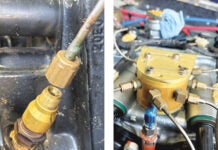For those of you using 48108-2 oil filters on an angle adapter, here’s a bit of trivia for you. Not everyone knows that these filters have an Anti-Drainback (ADB) valve (basically a rubber flapper) inside to hold oil in the filter element so that when you start the engine, the filter doesn’t have to fill before oil starts circulating in the engine’s galleries (its not as dramatic as it sounds—there is already lots of oil hiding throughout your engine).

Interestingly enough, the oil filter adapters that go straight back from engine use the 48110-X filters, which don’t have this ADB valve (we just looked into one, and its true!), the reasons being lost in the mists of time.
(This is also why punching a hole in the top of a filter installed on an angle adapter doesn’t drain the oil out of the filter, like it does with the 48110 on the straight adapters.)
With that background, we’ve always wondered just how much oil gets trapped inside the filter element by the ADB valve, and today we took a filter off one of our engines so that we could install a permanent/re-usable filter system for test purposes. Because we weren’t in our usual hurry to finish an oil change and move along, we took the time to carefully drain this one. The filter had been sitting on the engine for three days since the plane had been run, and once we got rid of the dripping oil that had been trapped between the filter base and the adapter, we had no more seepage. We then held the ADB Valve open with a dental pick – and got THIS much oil out of it.
So now you know—the ADB Valves really work, and they hold a lot of oil in the filter!














Paul,
Thanks for that info. I use a 48108-2 on my C175B with a GO-300 engine.
I’d like to relate a cautionary note on oil use.
Up until 2 years ago the engine use a qt of oil, P 20w-50 ,every 4-5 hours, ok but not great. Oil analysis was good with lead levels of about 1200 ppm.
2 years ago we replaced another cylinder, so we now had 5 relatively new cylinders, [ new cylinders, not overhauled].
After breaking in the new cylinder our oil use dropped to 12-14 hrs per qt.! We were excited to now only use 3-4 qt of oil between 50 hr changes, vs the 10-12 qts previously.
At our next 2 oil changes, the oil analysis showed a huge increase in lead, 2800 ppm. The drained oil was brown and thick.
Then, last Saturday I started the engine and it was running on 4-5 cylinders. Leaning didn’t help, mag check was no joy.
Back in the hangar, with the upper cowl removed, #1 and #3 were cold…
I removed the valve covers on both and found the #3 exhaust valve was stuck wide open.
I wound up reaming #3 as well as #1 and #5 exhaust guides.
I will now be changing oil at 30 hours and see what the analysis shows. If the lead is still high, I’ll go to 25 hours and see.
Inerestingly, Lycoming issued SSB 388C on checking exhaust valves for sticking ever 300-400 hours..!!
My Continental did the same with 350 hrs on #1 and #3.
Paul,
When will you do another “Kit Buyers Guide”? I can’t find one more recent than 2014?
Tim – We do a Buyer’s Guide every December, as well as maintaining an online Buyer’s Guide that is kept up to date all year.